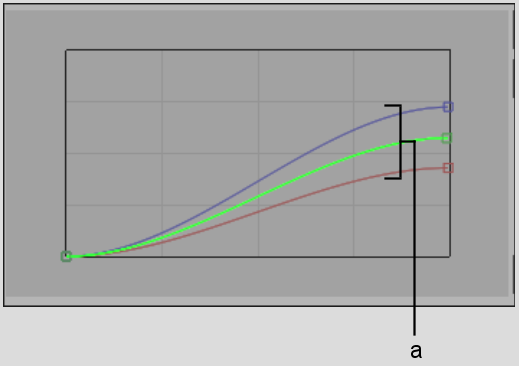Show in Contents

Add to Favorites

Home: Flint

Adding Monochrome Grain

Adding Grain to a Clip

Matching Grain between Clips

Adding Grain Using a Custom or Monochrome Grain Signature
Use the Custom option to
define Red, Green, and Blue Gain curves that are used to generate
the grain signature.
Using the Mono option, you can also apply custom
monochrome noise, an option that is useful if you are adding grain
to monochrome clips. Monochrome noise does not have to be black
and white noise. You can adjust the Red, Green, and Blue curves
to tint the grain in cases where you are adding grain to, for example,
sepia monochrome clips.
To
add grain by defining a custom colour or monochrome grain signature:
- From
the Grain Signature box, click Custom or Mono.
Instead of RGB sliders, the Custom option provides
Red, Green, and Blue Gain curves for each channel that you can edit
to produce the grain signature that you need:
- If
you select Custom, the noise associated with the grain signature
is colour noise.
- If
you select Mono, the noise is monochrome, though not necessarily black
and white. You can tint the grain you add by adjusting the Red, Green,
and Blue Gain curves.
- To
add grain to the clip, adjust the Red, Green, and Blue Gain curves.
The Red, Green, and Blue Gain curves represent
the degree of grain added along the vertical axis, and the corresponding
luma value of the selected channel on the horizontal axis. For example,
to add grain primarily at the higher luma range of the red channel,
drag the right-most control point of the red curve upward.
The Red, Green, and Blue Gain graph provides
a thorough set of controls that you can use to modify the Red, Green,
and Blue Gain curves as needed:
- Select
the curve that you want to modify by selecting the corresponding option
from the Channel box below the RGB Gain graph.
- To
modify the shape of the selected curve, press M to select
Move edit mode and then drag its control points.
- To
add control points to the selected curve, press A to select
Add edit mode and then click the curve at the location where you
want to add the control point.
- To
delete control points from the selected curve, press D to select Delete
edit mode and then click the control point that you want to delete.
- Use
the other edit mode options as needed. Editing these curves and
the options you can use are similar to editing animation curves.
See
Editing Keyframes.
- To
undo the previous modification, click Undo.
- To
reset the RGB Gain curves, click Reset.
- To
adjust the radius of the grain along the X-axis, drag the RGB Radius
X sliders:
- Enable
Proportional and drag the RGB Gain sliders to add grain proportionately
to the R, G, and B channels.
- Disable
Proportional and adjust the R, G, and B channels independently to
fine-tune the grain radius.
- To
adjust the radius of the grain along the Y-axis, drag the RGB Radius
Y sliders:
- Enable
Proportional and drag the R, G, and B Gain sliders to add grain
proportionately to the R, G, and B channels.
- Disable
Proportional and adjust the R, G, and B channels independently to
fine-tune the grain radius.
- When
you are satisfied with the result, click Process to add grain to
the clip or continue building
your processing pipeline in Batch.





